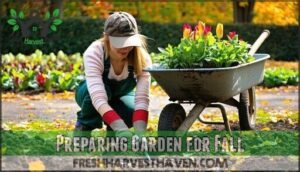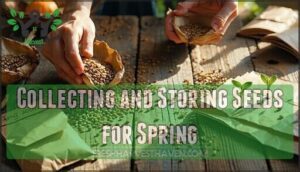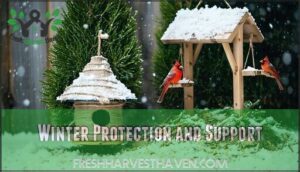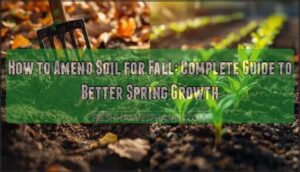This site is supported by our readers. We may earn a commission, at no cost to you, if you purchase through links.
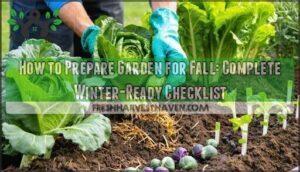
Clean up diseased plants and debris, then focus on the exciting stuff: planting cool-season vegetables like kale and Brussels sprouts, dividing overcrowded perennials, and tucking spring bulbs into the soil for next year’s surprise show.
Don’t forget to mulch tender plants for winter protection and leave some healthy stalks standing—they’re five-star hotels for beneficial insects.
Smart timing makes all the difference between a garden that merely survives winter and one that thrives.
Table Of Contents
- Key Takeaways
- Fall Garden Preparation
- Preparing Garden for Fall
- Planting and Propagation
- Garden Maintenance and Cleanup
- Winter Protection and Support
- Frequently Asked Questions (FAQs)
- How do I prepare my garden for fall?
- What should I do if my garden won’t grow in the fall?
- How do I prepare my garden for the new season?
- How do you care for a fall garden?
- What are some fall gardening tips?
- What is fall garden prep?
- What is the best time to plant a fall garden?
- Should you turn soil in autumn?
- What plants are good for the garden in the fall?
- How do you prepare a garden for winter?
- Conclusion
Key Takeaways
- Start your assessment early – Walk through your garden now to identify diseased plants, overcrowded areas, and pest issues before winter hits, giving you time to address problems systematically.
- Plant cool-season crops strategically – Get vegetables like kale, spinach, and Brussels sprouts in the ground 6-8 weeks before your first frost date for a productive fall harvest.
- Divide and multiply your perennials – Early fall is the perfect time to split overcrowded perennial clumps, creating healthier plants while giving you extras for other garden spots.
- Balance cleanup with wildlife support – Remove diseased debris and weeds, but leave healthy perennial stalks standing to provide winter shelter for beneficial insects and food sources for birds.
Fall Garden Preparation
Fall arrives fast, and your garden needs a head start to thrive through winter and beyond.
Take a walk through your beds now to spot what’s working, what’s struggling, and what needs your attention before the first frost hits.
Assessing Current Garden Conditions
Walking through your garden like a detective, you’ll spot what needs attention before winter arrives. This plant assessment reveals which areas need garden adjustments and helps you plan effective pest control strategies.
Proper space evaluation ensures your thriving plants get room to flourish while identifying struggling ones needing help. Considering soil pH levels is also vital for ideal nutrient availability.
- Check each plant’s overall condition and note yellowing, wilting, or stunted growth patterns
- Look for overcrowded areas where plants compete for sunlight, water, and nutrients
- Scan leaves and stems for small holes, sticky residue, or unusual spots indicating pest issues
- Examine soil around plant bases for compaction, poor drainage, or weed invasion
- Document which plants exceeded expectations and which disappointed for future planning
Identifying Plants for Pruning or Division
Take a close look at your garden’s cast of characters to spot which ones need attention. Check for plants bursting out of their designated spaces – these overgrown indicators signal it’s time for plant division or relocation.
Perennial care becomes essential when you notice crowded clumps or declining blooms. Dividing perennials fall timing works perfectly now, giving roots time to establish before winter.
Using the right tools can make dividing plants easier. Look for propagation potential in healthy specimens that could benefit from division, while noting which plants need pruning techniques to maintain their shape and vigor.
Checking for Pests and Diseases
Before you can tackle pruning and dividing, you’ll need to identify pests and diseases lurking in your garden.
Monitor plants weekly for signs of trouble like yellowing leaves, spots, or unusual insect activity.
Disease prevention starts with removing infected foliage immediately, and using organic controls like neem oil or beneficial insects for pest control fall strategies.
Consider seasonal pest management to protect your garden, and make garden disease management much easier by catching problems early, rather than fighting full-blown infestations later, which is a key part of disease prevention.
Preparing Garden for Fall
Fall is the perfect time to plant cool-season vegetables, divide overcrowded perennials, and get spring bulbs in the ground.
You’ll set yourself up for a thriving garden next year while extending this season’s harvest.
Planting Cool-Season Vegetables
Your fall garden thrives when you plant cool-weather crops at the right time.
Ideal Timing means starting 6-8 weeks before your first frost date. Soil preparation involves adding 2-3 inches of compost and maintaining pH between 6.0-7.0.
Choose frost-tolerant varieties like kale, spinach, and carrots for your fall vegetables. These coolweather crops handle temperature drops better than summer plants.
Proper watering needs and pest control keep your fall garden productive through autumn’s shorter days. For added protection, consider using lightweight row covers to shield plants from frost.
Dividing and Transplanting Perennials
While cool-season vegetables get established, your perennials might need attention too.
Early fall dividing perennials fall timing gives roots six weeks to settle before frost hits. Overgrown clumps benefit from division, creating healthier plants and extras for other garden spots.
Perennial Division Benefits and transplanting best practices:
- Tool Selection – Use a sharp spade and clean pruning shears to prevent disease spread
- Timing Considerations – Divide spring bloomers in fall, fall bloomers in spring for best results
- Post-Transplant Care – Water deeply after transplanting and apply light mulch around new divisions
- Plant maintenance – Cut back foliage by half to reduce transplant shock and conserve energy
- Fall garden maintenance – Mark divided areas so you remember what’s planted where come spring
Effective division requires the right perennial tools.
Planting Spring-Flowering Bulbs
Spring-flowering bulbs need planting six to eight weeks before your ground freezes solid. This timing lets roots establish properly during fall’s cooler weather.
Choose varieties that match your garden’s sunlight needs and soil drainage conditions.
| Bulb Type | Bulb Depth | Bulb Spacing |
|---|---|---|
| Tulips | 6-8 inches | 4-6 inches apart |
| Daffodils | 6-8 inches | 3-6 inches apart |
| Crocuses | 3-4 inches | 2-3 inches apart |
Plant bulbs pointy-end up in well-draining soil for best results during your fall garden prep routine, ensuring a successful fall garden with proper planting techniques.
Planting and Propagation
Fall’s your chance to multiply your garden through smart propagation techniques. You’ll secure next year’s plants by taking cuttings now and collecting seeds from this season’s best performers.
Planting at The Right Time for Fall
Timing your fall garden prep right means checking your area’s frost date and counting backward six to eight weeks.
Plant cool-season crops like kale and spinach when soil temps hit 50-70°F.
For spring bulbs, wait until soil cools but isn’t frozen—plant tulips and daffodils at depths two to three times their height.
Perennial establishment benefits from early fall planting, giving roots time to settle before winter, and your deciduous planting window stays open until a month before ground freeze.
Taking Cuttings for Indoor Overwintering
Many gardeners overlook cutting propagation, yet it’s your ticket to preserving favorite plants through winter’s harsh grip.
Take cuttings from healthy growth in late summer when temperatures hit that sweet spot of 65-75°F.
Choose softwood cuttings for quick rooting or semi-hardwood for tougher shrubs.
Use perlite-vermiculite cutting mediums for proper drainage and maintain 80% humidity control with a dome.
Daily misting keeps stems hydrated without waterlogging.
This overwintering indoors technique guarantees your prized plants survive for spring’s return.
Collecting and Storing Seeds for Spring
Autumn offers the perfect opportunity for seed collection from your thriving plants.
Wait until seed pods dry completely on the plant, then gather them on a sunny day.
Store seeds in labeled envelopes or small containers with proper ventilation, include collection dates and plant names for spring garden planning.
Test seed viability by placing a few in damp paper towels before storage.
Garden Maintenance and Cleanup
A clean, organized garden is your foundation for successful fall preparations and winter survival.
Removing debris, controlling weeds, and making thoughtful decisions about what to keep creates the ideal environment for your garden to thrive through the colder months ahead, ensuring a successful fall and winter.
Weeding and Removing Debris
Thorough weeding and debris removal create the foundation for healthy winter gardens.
You’ll want to tackle this job systematically, starting with the most congested areas where weeds compete fiercely for nutrients and water.
- Efficient Weeding: Use long-handled tools to remove weeds before they set seed, preventing next season’s problems
- Annual Removal: Clear spent annuals completely to eliminate hiding spots for overwintering pests and diseases
- Leaf Removal Garden: Rake diseased leaves away from plant bases but leave healthy ones for natural mulch
- Tool Maintenance: Clean tools between plants to avoid spreading pathogens throughout your fall garden cleanup
Preventing Garden Congestion and Disease
Clear out overcrowded plants to boost airflow importance and prevent disease outbreaks.
Proper plant spacing reduces humidity that breeds fungal problems, while strategic pruning techniques open up dense growth.
Remove diseased foliage immediately—don’t compost it.
This fall garden cleanup creates breathing room between plants, making pest control easier and disease prevention more effective.
Good airflow keeps your garden healthier through winter’s challenges ahead.
To further protect your plants, consider sterilizing garden tools to prevent disease spread and ensure a healthier garden with proper plant spacing.
Leaving Healthy Perennial Stalks for Wildlife
While removing debris and weeds keeps your fall garden healthy, consider your cleanup strategy carefully.
Healthy perennial stalks shouldn’t get the axe—they’re wildlife goldmines that support garden ecosystem balance.
Over 70% of overwintering insects depend on these stalks for winter shelter, while birds rely on seed heads for essential food.
This pollinator habitats approach boosts spring activity by 20%.
- Ladybugs and native bees huddle inside hollow stems, surviving harsh winter winds
- Goldfinches and chickadees feast on seed heads when other food sources disappear
- Beneficial insects emerge stronger in spring, ready to tackle garden pests naturally
- Your perennial garden becomes a beacon of life in winter’s stark landscape
Winter Protection and Support
Winter protection keeps your plants healthy through harsh weather while supporting beneficial wildlife. These simple steps help gardens thrive through cold months and prepare for spring success.
Mulching for Winter Protection
Winter protection begins with understanding that mulch acts as nature’s blanket for your garden beds. Apply a 2-3 inch layer of organic materials around plants, keeping mulch away from tree trunks and plant stems to prevent pest issues.
One key aspect of soil preparation is understanding proper soil composition for ideal aeration.
| Mulch Materials | Application Depth | Benefits |
|---|---|---|
| Shredded leaves | 2-3 inches | Improves soil as it decomposes |
| Wood chips | 3-4 inches | Long-lasting moisture retention |
| Straw | 4-6 inches | Excellent soil temperature control |
| Pine needles | 2-3 inches | Natural pest control properties |
| Compost | 1-2 inches | Adds nutrients while protecting |
Proper mulching garden beds maintains consistent soil temperature and prevents freeze-thaw cycles that damage roots. This simple step transforms your winterizing garden routine into effective plant protection.
Protecting Plants From Frost and Wind
Your tender plants need shields against winter’s harsh bite.
Cover delicate specimens with frost cloth or burlap wraps to prevent cold damage.
Apply anti-desiccant sprays to evergreen shrubs, reducing winter burn from harsh winds.
Stake young trees to protect against snow and wind damage.
Don’t forget your potted plants—bring them indoors before nighttime temperatures drop below 55°F for proper indoor plant care.
Supporting Overwintering Pollinators and Birds
Beyond protecting plants from harsh weather conditions, your fall garden maintenance should include creating safe havens for overwintering pollinators and birds.
These creatures need shelter, food sources, and water to survive winter months.
Here are three ways to support wildlife in your garden:
- Leave native plant stalks and seed heads standing – They provide natural shelter for beneficial insects and food for birds throughout winter
- Install winter bird feeders and maintain unfrozen water sources – Regular feeding stations boost bird survival rates while heated birdbaths prevent dehydration
- Create brush piles from pruned branches – These structures offer protection from elements and increase bird presence by 25% during cold months
Frequently Asked Questions (FAQs)
How do I prepare my garden for fall?
Many believe fall garden prep is just cleanup, but it actually sets the foundation for next year’s success.
Test your soil, add compost, plant cool-season crops, and mulch beds before frost arrives.
What should I do if my garden won’t grow in the fall?
Check your soil pH and nutrients first—acidic or depleted soil stunts growth.
Test drainage since waterlogged roots won’t develop properly.
Add compost, adjust pH, and make certain six hours of sunlight daily.
How do I prepare my garden for the new season?
Start by testing your soil’s pH and nutrient levels, then add compost or aged manure to restore nutrients. Plant cool-season crops, divide perennials, and mulch beds for winter protection.
How do you care for a fall garden?
Your fall garden transforms into a thriving oasis with regular watering, mulching, and deadheading.
Remove spent blooms, divide overcrowded perennials, and plant cool-season crops.
Protect tender plants from frost while maintaining consistent moisture levels.
What are some fall gardening tips?
Plant cool-season vegetables like kale and spinach six weeks before frost. Test and amend soil with compost. Divide overgrown perennials, plant spring bulbs, and mulch beds for winter protection.
What is fall garden prep?
Preparing your garden for fall means getting ready for cooler weather and next year’s growth.
You’ll test soil, add compost, plant cool-season crops, divide perennials, and protect tender plants from frost.
What is the best time to plant a fall garden?
Though you might think it’s too late to start, late summer to early fall is actually perfect timing for planting your fall garden.
You’ll want to get cool-season crops like kale, spinach, and carrots in the ground at least six weeks before your first expected frost.
Should you turn soil in autumn?
Yes, you should turn soil in autumn.
Fall soil preparation allows organic matter to decompose over winter, enriching nutrients naturally.
Add compost or aged manure when turning to restore nutrients and improve structure for spring planting success.
What plants are good for the garden in the fall?
Cool-season vegetables like kale, spinach, carrots, and broccoli thrive in fall’s mild temperatures. You’ll also want spring-flowering bulbs such as tulips and daffodils planted now for next year’s blooms.
How do you prepare a garden for winter?
Mulch protects roots, cover tender plants with burlap, drain hoses, bring potted plants indoors, and water evergreens until freeze.
Clean beds, stake young trees, and stock bird feeders for wildlife support.
Conclusion
Gardens that implement proper fall preparation show 40% better spring recovery rates compared to neglected ones.
Successfully learning how to prepare garden for fall sets the foundation for next year’s growing success.
You’ve now got the roadmap to transform your garden into a winter-ready sanctuary that’ll reward you with healthier plants, better yields, and fewer pest problems come spring.
Your future self will thank you for the effort you put in today to achieve better yields.
- https://homesteadgardens.com/fall-planting-preparation/
- https://www.natureconservancy.ca/en/what-we-do/resource-centre/conservation-101/10-ways-to-get-your-garden-ready-for-fall.html
- https://www.americanmeadows.com/content/fall-garden-maintenance-checklist
- https://mortonarb.org/plant-and-protect/tree-plant-care/plant-care-resources/fall-gardening-tips/
- https://16acresgardencenter.com/2024/08/07/preparing-your-garden-for-fall-tips-on-selecting-and-planting-fall-vegetables-and-flowers/

